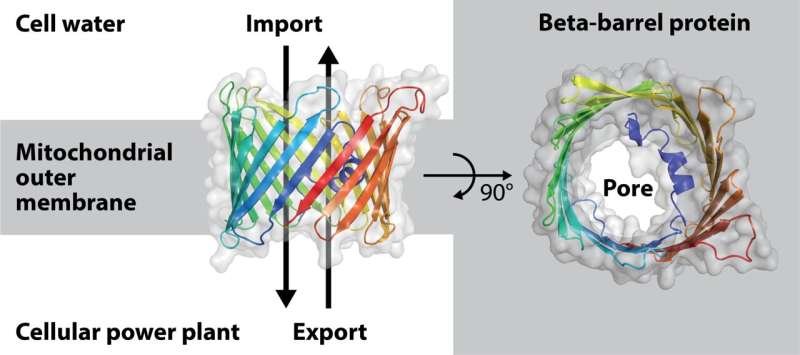This article has been reviewed according to Science X's editorial process and policies. Editors have highlighted the following attributes while ensuring the content's credibility:
fact-checked
peer-reviewed publication
proofread
Formation of pores in mitochondrial membrane elucidated

Mitochondria are considered to be the power plants of cells and are essential for human metabolism. Dysfunction in 40% of mitochondrial proteins are associated with human diseases, which is why mitochondria also play an important role in medical research.
A previously unexplained process in the complex mitochondria was the formation of their barrel pores. These are located within the mitochondrial outer membrane and serve as a portal through which substances are exchanged between mitochondria and the cell water.
Researchers at the University of Freiburg and the University of Kyoto/Japan have now been able to elucidate the guidance mechanism by which the pores are formed through structural and functional experiments. The study by the team led by Prof. Dr. Nils Wiedemann and Prof. Dr. Nikolaus Pfanner from the Faculty of Medicine and the Cluster of Excellence CIBSS at the University of Freiburg and by Prof. Dr. Toshiya Endo from Kyoto Sangyo University has been published in the journal Nature Structural & Molecular Biology.
"Barrel pores are essential for life, as they are indispensable for the exchange of substances within cells," explains Wiedemann. "Understanding them better is an important building block for basic cellular research."
Similarities to the wine barrel structure
It was already known that the barrel pores in mitochondria are made of a protein molecule that has to be folded up to 19 times through the outer membrane for this purpose. These so-called beta-strands, which span the outer membrane, are arranged in a circle like the longitudinal woods/staves of barrels used in wine production, so that a pore is formed in the mitochondrial outer membrane. Beta-barrel proteins are assembled by the sorting and assembly machinery (SAM) in the mitochondrial outer membrane.
Roles of Sam50 and Sam37
By purifying and elucidating for the first time a protein complex structure of the sorting and assembly machinery together with a beta-barrel protein during beta-barrel formation, it was proven that the last beta strand of beta-barrel proteins is first attached to Sam50 (a protein subunit of the sorting and assembly machinery) in the mitochondrial outer membrane. Then, the other strands are assembled one by one. In this process, the part of the protein chain of beta-barrel proteins upstream of the strands is important not only for their function but also for their assembly.
In contrast, the Sam37 subunit has a protrusion that extends into the mitochondrial outer membrane, around which the strands of the beta-barrel proteins are arranged in a circular fashion. Functional experiments in which the protrusion of Sam37 was removed showed that the protrusion is critical for ring closure of the beta-barrel proteins. "This allowed us to assign the Sam37 subunit a function as a cooper/barrel maker for the formation of the vital beta-barrel membrane proteins in our cellular power plants," Wiedemann explains.
More information: Nikolaus Pfanner, A multipoint guidance mechanism for β-barrel folding on the SAM complex, Nature Structural & Molecular Biology (2023). DOI: 10.1038/s41594-022-00897-2 . www.nature.com/articles/s41594-022-00897-2
Journal information: Nature Structural & Molecular Biology
Provided by Albert-Ludwigs-Universität Freiburg im Breisgau


















